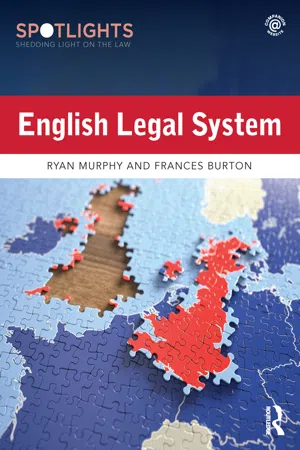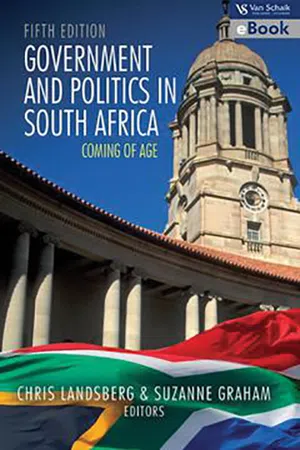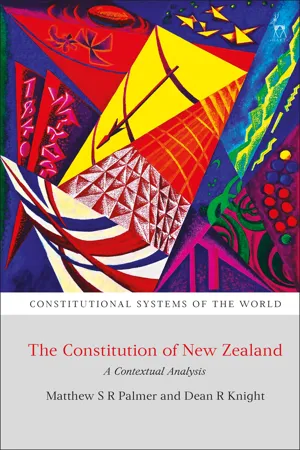Law
Role of Judiciary
The role of the judiciary is to interpret and apply the law, resolve disputes, and ensure justice is served. It acts as a check on the legislative and executive branches of government, upholding the rule of law and protecting individual rights. Through its decisions, the judiciary establishes legal precedents that guide future cases and contribute to the development of the legal system.
Written by Perlego with AI-assistance
7 Key excerpts on "Role of Judiciary"
Learn about this page
Index pages curate the most relevant extracts from our library of academic textbooks. They’ve been created using an in-house natural language model (NLM), each adding context and meaning to key research topics.
- eBook - ePub
- Ryan Murphy, Frances Burton(Authors)
- 2020(Publication Date)
- Routledge(Publisher)
The judiciary do not operate in isolation but form an integral part of the overall system. For more on the core role of the judiciary, look at the chapters on statutory interpretation (Chapter 6) and judicial precedent (Chapter 9). To explore the way in which the judiciary interacts with other parts of the legal system, look at the chapter on sources of law (Chapter 2) and the institutions of law-making (Chapter 3). For a richer understanding of how judges contribute to particular areas of the justice system, refer to the criminal justice (Chapter 11) and civil justice (Chapter 10) parts of the textbook. This section of the textbook focusses primarily on judicial office holders and does not deal with the system of lay magistrates in any level of detail, despite the fact that since early medieval times magistrates courts have been the location of the start of both civil and criminal cases and every criminal case to this day begins in a magistrates court (for which see Chapter 11). The website that accompanies this text has a separate section dedicated to the magistracy and the role that they play in the legal system. To talk of the ‘judicial function’ or the ‘role of the judiciary’ is to treat the ‘judiciary’ as if it is a single role or function but this fundamentally misunderstands the nature of the judicial task. Any text seeking to differentiate the institutions of the legal system will claim that the judiciary ‘apply’ and ‘interpret’ the law and that they act as the ‘resolvers of disputes’. 1 These three pillars of the judicial system risk oversimplifying what it is that judges do and how they do it. There are multiple roles within the judiciary and different types of judges have responsibility not only for different areas of law and different types of dispute but also for different aspects of the justice system and for performing aspects of these overarching tasks of application and interpretation to varying degree - eBook - ePub
- Landsberg C, S Graham, Landsberg C, S Graham(Authors)
- 2017(Publication Date)
- Van Schaik Publishers(Publisher)
There is a dispute when we are apprehended for theft. Was it us or somebody else? There is a dispute when we fail to pay our monthly premiums on the car. Did we commit a breach of contract and, if so, what was the damage caused to the car dealer? There is a dispute when we allege that our rights have been infringed upon. Were they in fact infringed upon, and if so, did the infringement comply with the requirements for the lawful limitation of the rights? This is where the third branch of the trias politica, the judiciary (commonly called the courts), comes in. The function of the judiciary is to resolve these disputes by determining what the law is and how it should be applied to every dispute (Shetreet, 1988: 468). In other words, the courts must determine which rule of law applies to the dispute, interpret it and apply it to resolve the dispute. In the process, the courts have the power to adjudicate on our actions as citizens of the State, as well as on those of the other branches of government, the legislature and the executive. The judiciary is the official referee of society (Shapiro, 1975: 328; Du Plessis & Du Plessis, 1990: 86). The constitution provides that the 71 judicial authority of the republic is vested in the courts (section 165(1)). Key concept: Judicial function The judicial function is the function of the courts as impartial referees to resolve legal disputes by determining which rule of law applies and what it means, and by applying it in an authoritative way to the facts of the particular legal dispute. The traditional view was that the courts only applied the law; they did not make it. Today, there is no question that, in the application of a rule of law to an actual case, the courts do have a law-making function (Shapiro, 1975: 342ff). This function is, however, limited and is not as comprehensive as that of the legislature - eBook - ePub
- Gary Slapper, David Kelly(Authors)
- 2009(Publication Date)
- Routledge-Cavendish(Publisher)
The judiciary4.1 Introduction
The importance of the courts and the judges within the common law has already been considered in previous chapters of this book. It has been suggested that the judges have considerable scope for determining the meaning and effect of law through their development of the rules of precedent and statutory interpretation. The purpose of the present chapter is further to judges, how they are appointed and how the operation of their judicial consider those issues but more essentially to consider the actual roles of functions may raise constitutional issues as to the interests the judiciary represent.4.2 The constitutional role of the judiciary
Central to the general idea of the rule of law, judges are at the heart of the law. The earliest judges used to rely on divine wisdom to settle cases. The judicial function was largely one of supervising events—like trial by ordeal—designed to reveal a divine truth. Later, judges came to have the function of applying what today we would call ‘rules of procedure’ to decide cases. Before there was any significant written law, judges were reliant on what communities said was the custom by which ownership of something was determined, or rights of way were established, or what was right and what wrong behaviour. So judges referred the arguments according to set procedures. It was from such a system that the doctrine of precedent developed. Judges eventually came to be officially appointed as part of ‘the King’s Court’, a body that included all sorts of officials. The law ‘court’ system today originates in the forum that served the monarch—the royal court. Today, until judges apply the law in cases, it can often be difficult to imagine or guess what exactly is meant by the law as it appears on the pages of parliamentary legislation or previous judgments. And not only do judges shed light on the meaning of laws, they have actually created many of them. - eBook - ePub
The Constitution of New Zealand
A Contextual Analysis
- Matthew SR Palmer, Dean R Knight(Authors)
- 2022(Publication Date)
- Hart Publishing(Publisher)
7Introduction – Rule of Law and Forms of Law – Judiciary as an Institution – Judicial Independence and Accountability – ConclusionJudiciaryI. INTRODUCTIONT he judicial branch of government decides what the law means and how it applies to any particular case brought to court. In doing that, judges make law: the ‘common law’. That simple description indicates what is different about the judicial function compared with the legislative and the executive functions. The power of interpreting law, and creating common law, can be significant. But the judiciary’s powers are exercised in the specific context of individual cases. The judges do not initiate cases; they judge the cases brought to court. They must give reasons for, and put their names to, each decision. A court’s decision is always subject to at least one appeal as of right, and the senior appellate courts are composed of panels of judges. As we saw in the last chapter, court decisions can be overridden by legislation if Parliament chooses.In this chapter, consistent with our emphasis on function over form, we start with the adjudicative function of judges and the rule of law. We then turn to the judiciary as an institution within New Zealand’s constitutional system, including its structure and processes, as well as the daily practice of what judges do. Finally, we canvass aspects of the reality of judicial independence and judicial accountability in New Zealand.II. THE RULE OF LAW AND FORMS OF LAWThe question ‘what is law’ is as old as law itself. In simple terms we think of it as publicly stated rules about human behaviour that are enforced by state-imposed sanctions. In reality there is a continuum of sorts. There are many sources of expectations of human behaviour, including those formed and expressed by the evolution of social norms and explicitly demanded by different groups within a society. Here, we look at the different ways the courts determine the nature and meaning of law in the course of adjudication. First, we explain the rule of law as a constitutional principle in New Zealand. - Peter Joyce(Author)
- 2015(Publication Date)
- Teach Yourself(Publisher)
‘Judicial review in the UK comprises an assessment of a decision made by a public body (which includes government departments, local authorities, tribunals. Or any other organization that exercises a public function …)… The basis on which judicial intervention is founded is the doctrine of ultra vires which suggests that a public body has acted beyond its authorized limits … In countries that possess codified constitutions, the judiciary are responsible for ensuring that the constitution is upheld. Senior courts (such as the American Supreme Court or the French Conseil Constitutionnel) perform this function’ (Joyce and Wain, 2010: 112–113).Joyce, P. and Wain, N. (2010) A Dictionary of Criminal Justice. London: Routledge.However, in the UK, the 1998 Human Rights Act provided the judiciary with the ability to warn parliament that a piece of legislation was contrary to the European Declaration of Human Rights. The Courts were not able to annul or strike down legislation that they considered to be contravening the Declaration but, instead, were able to issue a Declaration of Incompatibility which urged the government and parliament to reconsider the issue. We considered this matter in Chapter 9 .Judicial interpretation
The role of judges may sometimes extend beyond administering the law and entail them determining its content. This is known as judicial law making (or judicial activism).Key idea (4) THE STRICT LETTER OF THE LAWIn theory, the role of judges is to apply the law to the matter that comes before them. However, it is often argued that judges go beyond this role and effectively determine its contents, which are subsequently binding on courts dealing with similar cases. This situation arises as a result of judicial interpretation of such documents that may effectively give judges the ability to act in a law-making capacity. Judges differ, however, in the principles which they apply when interpreting the law or constitution. These are now discussed.Some judges rigidly apply the wording of the statute or constitution to the case that is before them. The judge’s interpretation, therefore, is little more than the citation of existing sources as the basis for the decision which they reach. A case is determined according to the strict letter of the law. This strict interpretation view of the role of the judiciary tends to promote a conservative approach to judicial interpretation. It suggests that issues that are not contained in a country’s law or constitution cannot be inserted into it by judges. Those who endorse such a view regard this as either the work of legislators or as a matter which should be responded to by the process of constitutional amendment.- eBook - ePub
The Constitution of Italy
A Contextual Analysis
- Marta Cartabia, Nicola Lupo(Authors)
- 2022(Publication Date)
- Hart Publishing(Publisher)
8The JudiciaryJudicial Function – Separation of Powers – Judicial independence – High Council of the Judiciary – Unity of Jurisdiction – Supreme Court of Cassation – Special Judges – Administrative Courts – Council of State – Regional Administrative Courts – Public Prosecutors – Natural Judge – Impartiality – Fair Trial – Judicial ResponsibilityI. INTRODUCTION‘J udges shall be subject only to the law’ reads Article 101.2 of the Constitution. This is the core constitutional principle that depicts the position of courts within the overall constitutional architecture of powers, and reveals the understanding of the judicial function entrenched in the Italian Constitution.On the one hand, this constitutional principle proclaims the independence of judicial bodies and aims to protect the judiciary from all external pressures and interference, especially from the political branches, in contrast with the previous practice, notably during the fascist era, when judges were officials subject to the government and bound by its political directives. As it has been rightly observed, ‘There is no liberty, if the judiciary power be not separated from the legislative and executive’.1On the other hand, Article 101 endorses an understanding of the judiciary as a neutral power, whose mission is to enforce with virtually no discretionary power the legislation adopted by Parliament. This understanding echoes Montesquieu’s definition of the judge as the bouche de la loi and suggests that the judicial function is that of simply implementing the legislation passed by Parliament in the context of actual controversies, drawing a clear-cut line between legis-latio and juris-dictio. That is why the Constitution does not characterise the judiciary as a ‘power’, but as a ‘branch’ (ordine - eBook - ePub
The Constitution of the United Kingdom
A Contextual Analysis
- Peter Leyland(Author)
- 2021(Publication Date)
- Hart Publishing(Publisher)
70 Formal equality under the law means very little if a large proportion of the population suffers from economic and social marginalisation. From a left-of-centre standpoint constitutional rights need to be defined beyond the liberal agenda of freedom of speech, religion, and assembly, to include basic rights to housing, health, and education. Furthermore, in the current environment particularly in light of introduction of court fees and cuts to the availability of legal aid contained in the Legal Aid, Sentencing and Punishment of Offenders Act 2012, viewed from the standpoint of potential claimants the question of equality in terms of access to the law itself is controversial. A reduction in the availability of legal assistance means that for many people the prospect of obtaining redress in the courts is not a realistic option. As a result there has been the emergence of alternative forms of redress, such as ombudsmen, law centres, and mediation.On the positive side, the rule of law has left the UK with a political and legal culture with an emphasis on due process. Put in simple terms, there is an expectation that government and the apparatus of state power will be exercised by ministers and officials operating within the law. In turn, this power is arbitrated by an independent judiciary. It is generally the case that rule of law principles operate as a set of institutional restraints to the exercise of executive power. The rule of law addresses certainty in decision making and it determines how a satisfactory balance between rule and discretion can be reached when putting the law into effect. The problems might arise if the courts become too intrusive, as many would argue that the judges should have a subordinate role to a democratically elected Parliament and any government formed from it.71 Nevertheless, the judicial oversight function is very important and is closely related to the role of judicial review in its supervisory role under the ultra vires principle which will be discussed later (see Chapter 7 ). As Sir Stephen Sedley observes in his defence of the development of judicial review, the position was concisely summarised by Lord Nolan: ‘The proper constitutional relationship of the executive with the courts is that the courts will respect all acts of the executive within its lawful province, and the executive will respect all decisions of the courts as to what its lawful province is’.72






